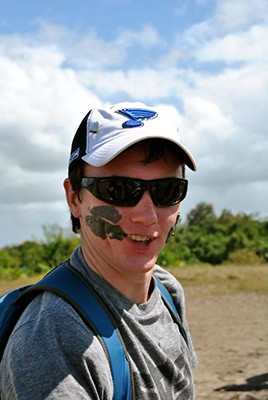Darragh O'Connor

B.Sc. (Honours) Thesis
Petrogenesis of Nepheline Syenites and Phonolites from the Lofdal Intrusive Complex, Kunene Region, Namibia
(PDF - 13 Mb)
Petrographic descriptions and mineral chemistry analyses of the nepheline syenite plugs and phonolite dykes of the Lofdal intrusive complex, northwestern Namibia, reveal primary insights into the sequence of magma crystallization with implications for nepheline syenite and phonolite association, for determining the nature of accessory mineral phases, and for any information on the nature of rare earth elements (REEs) associated with accessory mineral phases. The Lofdal intrusive complex is a 750 m.y. old set of intrusive bodies composed of syenite, nepheline syenite, phonolite, diatreme breccias, and carbonatite. These are found intruded through the Welwitschia inlier of the 2.0 b.y. old Huab Metamorphic Complex (HMC) in northwestern Namibia. Field relations indicate an early intrusive silicate assemblage of dominantly nepheline syenite followed by intrusive dykes of phonolite and then carbonatite. The Lodal intrusive complex comprises a central set of intrusive plugs of nepheline syenite with associated southwest to northeast striking dykes of phonolite and carbonatite.
Rare earth element mineralization and enrichment is currently being explored within the carbonatite dykes and related hydrothermal alteration of the Lofdal intrusive complex. The REE-mineralization is variable throughout the complex and includes both light-REE and heavy-REE mineralization. Current exploration has suggested that the two enrichments occur separately from one another. The heavy-REE enrichment is evident to have occurred during late stage hydrothermal activity and is dominated by the mineral xenotime.
Twenty one samples of nepheline syenite and phonolite of the Lofdal intrusive complex underwent complete analysis to understand the mineral assemblages and crystallization sequence of these assemblages. These descriptions show an overall similar mineralogical assemblage in the nepheline syenites and phonolites with both major-rock forming minerals and accessory and light-REE mineralization. EMP analyses of feldspars and biotites from nepheline syenite and phonolite suggest a co-magmatic relationship between the two rock units, strengthening the current model for silicate-carbonate (nepheline syenite-phonolite-carbonatite) magmatic intrusive rocks. Future work should continue with exploring the relationship of REE-mineralization of nepheline syenites and phonolites and try to relate this to the later enrichment of heavy-REE mineralization with carbonatite plugs and dykes.
Keywords:
Pages: 111
Supervisors: Yana Fedortchouk / Scott Swinden



